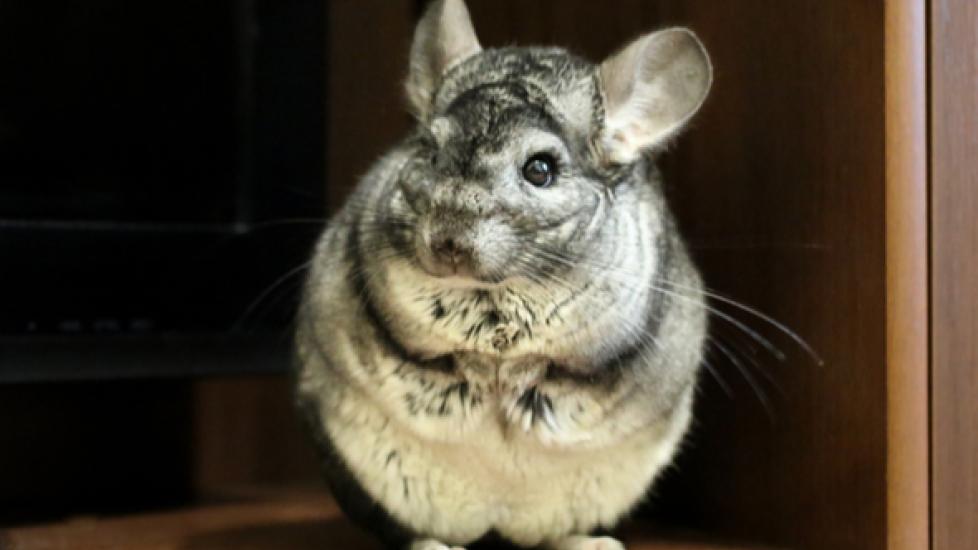Have You Ever Seen Your Pet Chinchilla or Guinea Pig Popcorning?
When pet guinea pigs and pet chinchillas are happy, they literally jump for joy. This behavior, frequently called “popcorning” (or less often, “pogoing”—as if jumping up and down on a pogo stick—or “pronking,” “pronging” or “stotting”), happens in both species spontaneously and can be quite confusing to guinea pig and chinchilla owners when they see it for the first time.
What Does Chinchilla or Guinea Pig Popcorning Look Like?
With pet chinchilla and guinea pig popcorning, the animals either jump straight up on all four legs from a standing position, like a kernel of popcorn popping in a pan, or they run forward and backward quickly first, sometimes kicking out their front and back legs, like a bucking bull. Guinea pigs may run back and forth in different directions first and may make high-pitched squeaking sounds simultaneously. Happy chinchillas may also make softer, repeated squeaking sounds.
Both guinea pigs and chinchillas may spontaneously popcorn once or repeatedly, without anything triggering this behavior, or they may popcorn in response to receiving food or attention. This behavior is more common in younger pet chinchillas and guinea pigs, but may be displayed by adults, as well.
Guinea pigs may be able to jump several inches in the air, while young chinchillas may attain several feet. Older or heavier animals may not be able to jump as high as their younger, spryer counterparts.
Chinchillas also display happiness by “wall-surfing,” where they run up and down the wall when they are excited. As chinchillas are nocturnal, they may popcorn and wall-surf more often at night because they tend to sleep during the day.
Why Do Guinea Pigs and Chinchillas Popcorn?
Typically, pet chinchillas and guinea pigs display this behavior when they are happy and excited. When guinea pigs and chinchillas are well-fed, have fresh water to drink, have room to exercise, receive attention from their owners and feel safe, they will typically popcorn in delight.
Rarely, however, these animals demonstrate this activity when they are scared. Generally, owners can tell whether their popcorning pets are joyful or fearful by looking at their animals’ body language, listening to their vocalizations, and surveying the situation to see if anything could be eliciting fear.
Joyful animals look relaxed, rather than on high alert, as scared prey animals such as guinea pigs and chinchillas typically do when they’re afraid. Also, fearful guinea pigs may let out high-pitched shrieks or growls, as opposed to short squeaks, purrs or “chuts” (a series of short, staccato noises) that happy guinea pigs make, while scared chinchillas may make barking or clicking sounds.
Should Pet Parents Worry If Their Pets Perform This Behavior or If They Don’t at All?
Sometimes owners will see their pet chinchillas or guinea pigs popcorning for the first time and think these animals are having seizures. However, animals that seizure typically fall over to one side and twitch and flail uncontrollably, rather than pop up into the air.
Popcorning is a normal guinea pig and chinchilla behavior that these rodents have complete control of, and it is completely safe.
On the other hand, some owners familiar with popcorning become concerned that their animals aren’t happy because they aren’t popcorning. Not all guinea pigs and chinchillas popcorn when they are content, and not performing this behavior doesn’t mean that the animals aren’t happy.
Pet parents can encourage chinchilla and guinea pig popcorning by handling them gently and by providing them with lots of time out of their cages to run around; plenty of fresh hay and water; and smaller amounts of pellets, fresh veggies and occasional treats. Many guinea pigs popcorn less or stop popcorning as they age. Well-cared for guinea pigs and pet chinchillas may be perfectly content, yet they may not popcorn.
So, don’t despair if you don’t see your precious pet perform this funny behavior, but certainly relax and enjoy watching him if he does!
Image via Vadym Plysiuk/Shutterstock
